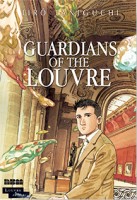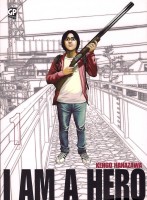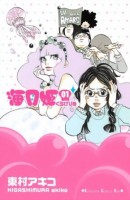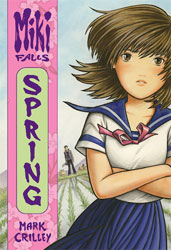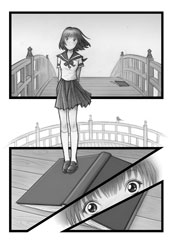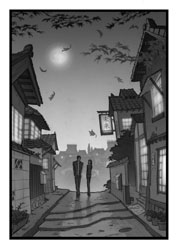We’re kicking off 2016 with a look at the manga titles and trends we’re most excited about. Joining me and Brigid is manga journalist and critic Deb Aoki, former guide to AboutManga.com, current host of Manga Comics Manga, and Publishers Weekly contributor.
What new manga are we looking forward to this year?
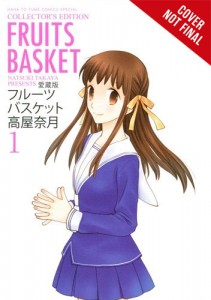 BRIGID: Fruits Basket! Natsuki Takaya’s tangled tale of a cursed family was one of the first shoujo manga I ever read, and I’m looking forward to re-reading it with a more experienced eye (and a better translation).
BRIGID: Fruits Basket! Natsuki Takaya’s tangled tale of a cursed family was one of the first shoujo manga I ever read, and I’m looking forward to re-reading it with a more experienced eye (and a better translation).
The other upcoming manga that everyone seems to be looking forward to is Princess Jellyfish, which Kodansha is publishing in double-sized omnibus volumes. This josei title about a bunch of nerdy girls living in their own rooming house sounds like it will be a lot of fun.
In terms of continuing series, I loved the first volume of Planetes and I’m looking forward to more. It’s a smart science fiction story with likeable characters and thoughtful storylines, and Dark Horse’s new edition is a beautiful two-volume omnibus that really feels like something special. I can’t wait to read more of Hiroya Oku’s Inuyashiki, about two humans given extreme superpowers in a freak accident—one uses them for good, one… doesn’t—and Yoshitoki Ōima’s A Silent Voice, an amazingly powerful story that’s about bullying but also about alienation and redemption. One more: Your Lie in April, which has kind of slid under the radar, a shonen romance about musicians that, like A Silent Voice, goes beyond the standard shonen romance tropes and has relatable characters experiencing real emotions.
On a general note: When I was compiling my lists of the best new and ongoing manga series of 2015, I was struck by how many really good manga debuted in 2015. From all accounts, 2016 is going to be even better.
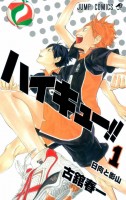 DEB: I’m most excited about the trend where manga publishers are taking chances on titles and genres that were once considered the third rail/extra risky to license, like sports manga. Super excited about the Summer 2016 arrival of the first volumes of Haikyu!! by Haruichi Furudate and Kuroko’s Basketball by Tadatoshi Fujimaki from Shonen Jump/VIZ Media! I love Haikyu!! a lot — been watching the first and second seasons on Crunchyroll over and over again. the characters are really wonderful — it’s delightful to see the team grow and reach new heights every time. It’s got lots of heart and humor as well as exciting sports action. It’s now one of my all-time faves!
DEB: I’m most excited about the trend where manga publishers are taking chances on titles and genres that were once considered the third rail/extra risky to license, like sports manga. Super excited about the Summer 2016 arrival of the first volumes of Haikyu!! by Haruichi Furudate and Kuroko’s Basketball by Tadatoshi Fujimaki from Shonen Jump/VIZ Media! I love Haikyu!! a lot — been watching the first and second seasons on Crunchyroll over and over again. the characters are really wonderful — it’s delightful to see the team grow and reach new heights every time. It’s got lots of heart and humor as well as exciting sports action. It’s now one of my all-time faves!
I’ve also been enjoying the recently released Yowamushi Pedal by Wataru Watanabe, a manga about a hapless anime otaku who discovers that he has a talent for bicycle racing. Big ups to Yen Press for publishing this fairly long series in double-sized volumes.
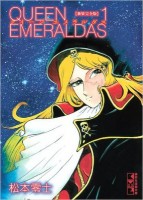 Another example of manga publishing biz in the US dipping their toes into riskier fare is the upcoming publication of three classics: Rose of Versailles by Riyoko Ikeda from Udon Entertainment, Queen Emeraldas by Leiji Matsumoto from Kodansha Comics, and Otherworld Barbara by Moto Hagio from Fantagraphics Books. For too long, the classics that are the foundation of manga in Japan have been largely unavailable in English. I’m hoping that these titles succeed so we can someday get more.
Another example of manga publishing biz in the US dipping their toes into riskier fare is the upcoming publication of three classics: Rose of Versailles by Riyoko Ikeda from Udon Entertainment, Queen Emeraldas by Leiji Matsumoto from Kodansha Comics, and Otherworld Barbara by Moto Hagio from Fantagraphics Books. For too long, the classics that are the foundation of manga in Japan have been largely unavailable in English. I’m hoping that these titles succeed so we can someday get more.
Also super excited about having more manga by Asano Inio available in English. Solanin and What a Wonderful World! are go-to recommendations for anyone who loves indie comics and is curious about manga. Now VIZ Media is publishing the mind-bending Goodnight Pun Pun, and A Girl on the Shore, coming from Vertical Comics. Both should be on your pre-order lists, as these are beautifully drawn, thought-provoking books that everyone will be talking about in the months to come.
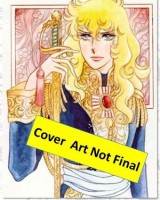 KATE: I share Deb’s excitement about classic manga. It’s a risky undertaking for any publisher, especially when so many readers are young (under 20) and not particularly curious about the medium’s roots. It will be interesting to see if UDON can pitch Rose of Versailles to the Shojo Beat crowd; though the artwork is a little dated, the melodrama, costumes, and kick-butt female lead have obvious parallels with titles in VIZ, Kodansha, and Yen’s catalogs. Who knows? It could be a surprise hit.
KATE: I share Deb’s excitement about classic manga. It’s a risky undertaking for any publisher, especially when so many readers are young (under 20) and not particularly curious about the medium’s roots. It will be interesting to see if UDON can pitch Rose of Versailles to the Shojo Beat crowd; though the artwork is a little dated, the melodrama, costumes, and kick-butt female lead have obvious parallels with titles in VIZ, Kodansha, and Yen’s catalogs. Who knows? It could be a surprise hit.
Speaking of vintage titles, I’m ecstatic about Drawn & Quarterly’s new Kitaro volumes. D&Q will be releasing these previously untranslated stories in slimmer, kid-friendly editions–a departure from their 2013 Kitaro release, which screamed “prestige project!” I think that’s a smart move: adults with an interest in Shigeru Mizuki’s work will buy it in almost any format, but younger manga fans need a length and trim size that reflects their own reading habits.
Another title on my must-read list is Jiro Taniguchi’s Guardians of the Louvre, which NBM Publishing will be releasing in April. The previous installment of the Louvre series–Hirohiko Araki’s Rohan at the Louvre–was the ultimate otaku two-fer: a ghost story and a standalone chapter in the JoJo’s Bizarre Adventure saga. Taniguchi’s book will undoubtedly be a more sober affair, but one I’m anticipating with the same eagerness: I can’t wait to see how Taniguchi integrates the museum’s famous collection into his story.
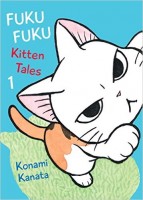 In the just-for-fun department, I Am a Hero, a zombie thriller from Dark Horse, is near the top of my list, as are VIZ’s Haikyu! (mentioned by Deb above), Vertical’s FukuFuku: Kitten Tales, and the final installment of DC Comics’ Batman: The Jiro Kuwata Batmanga. I’m also looking forward to Wandering Island, a story about a gutsy young woman who runs an air mail service in a remote corner of Japan. The illustrations are by Kenji Tsurata, the creator of the criminally under-appreciated Spirit of Wonder, which was published by Dark Horse in 1998.
In the just-for-fun department, I Am a Hero, a zombie thriller from Dark Horse, is near the top of my list, as are VIZ’s Haikyu! (mentioned by Deb above), Vertical’s FukuFuku: Kitten Tales, and the final installment of DC Comics’ Batman: The Jiro Kuwata Batmanga. I’m also looking forward to Wandering Island, a story about a gutsy young woman who runs an air mail service in a remote corner of Japan. The illustrations are by Kenji Tsurata, the creator of the criminally under-appreciated Spirit of Wonder, which was published by Dark Horse in 1998.
Last but not least, I’d also make a plug for The Osamu Tezuka Story: A Life in Anime and Manga. This visual biography clocks in at a hefty 900 pages, highlighting important periods in Tezuka’s career as an illustrator and animator. Its author, Toshio Ban, worked closely with Tezuka in the 1970s and 1980s, giving Ban a unique perspective on his subject. As an added bonus for American readers, Stone Bridge Press brought in Frederick L. Schodt to do the translation.
How about conventions—does anything look particularly tempting?
DEB: I’m always curious to see what Toronto Comic Arts Festival will be bringing as their guests this May. Last year was Gurihiru and Aya Kanno, prior years brought Konami Kanata, Moyoco Anno, Akira Himekawa, Usamaru Furuya, Est Em, Natsume Ono and Yoshihiro Tatsumi to name just a few. I don’t know what they have planned, but I know it’ll be worth the trip!
As booth space and tickets get harder and harder to get at San Diego Comic-Con, Anime Expo in Los Angeles has turned into the Japanese content biz must-go show. I’ve noticed that more companies from Japan are buying booths, and see lots of meetings / business being conducted at the show.
It’s great that AX is getting bigger and bigger, but I worry that it creates a situation where the anime/manga world becomes even more segregated/separated from the general pop culture community that converges at Comic-Con and similar American shows. This is especially irksome because it seems like most of the Western comics / pop culture press corps basically ignore / don’t report on / don’t attend Anime Expo or any of the announcements that come out of this show.
This pisses me off because anime/manga matter more than ever — especially as its fandom tend to skew younger, are more active, and more interested in all kinds of entertainment from US and Japan compared to their counterparts on the superhero side of the comic shop. So much for my “be less crabby in 2016” resolution… ;-)
KATE: I had a blast attending shows like New York Comic Con and Wondercon in the late 2000s. The last time I attended NYCC, however, I felt that the show had taken a much sharper turn towards the television, film, and gaming industries, and was losing its identity as a comics convention. The manga publishers were still there, of course, but it was harder to circulate and interact with editors and sales reps because of the enormous crowds. That experience pretty much soured me on going to any more big conventions. TCAF always sounds like a blast, but the timing never works for me; I’m always knee-deep in final exams and student papers when it rolls around!
BRIGID: I echo Deb’s concern about AX, but it does seem like this year, the news was spread across a broader swath of conventions—and many of the new licenses, including Fruits Basket, were announced on Twitter. The presence of so many people from the Japanese publishers—not just creators but editorial staff as well—was very noticeable this year and shows that the publishers are taking the American audience seriously. It also enhanced the experience to see, for instance, the editor of Noragami explaining the process of how it went from sketches to finished page. I’m looking forward to more of that at the larger shows as well as the more intimate experience at the smaller shows, where the creators and their readers are not so far apart.
Any predictions about the industry?
DEB: Almost all signs point to a healthier, more robust manga publishing business in 2016, which is a great thing. I don’t see the same rush to publish anything and everything vaguely manga-ish (even crappy manga) that I saw prior to the crash of the late 2000’s — publishers seem to be making more careful choices, more calculated risks. The fact that they’re taking any risks at all — by expanding genres, offering their stories via more digital channels and doing more simulpub/same day as Japan releases, is a good sign.
I’m also intrigued/encouraged by the efforts being made by Japanese manga publishers to welcome submissions by creators from outside of Japan, like Comics Zenon’s Silent Manga Audition contests and the Japanese edition of Shonen Jump’s latest contest to get published in their online magazine, Jump Plus. It’s no secret that many up-and-coming comics creators from around the world are inspired by manga, so it’ll be very interesting to see what happens when more of these creators get exposure in Japan and guidance from Japan’s top-notch manga editors.
 KATE: I’m consistently impressed by Seven Seas’ tenacity and business acumen, but not so impressed with the actual titles they license. Last year, however, Seven Seas published The Ancient Magus’ Bride and acquired Orange, neither of which fit the profile of a typical Seven Seas manga; if anything, both seemed like the kind of titles that CMX used to license. That gamble has paid off with Bride, which recently cracked the NY Times Manga Bestseller list. My prediction: Seven Seas will continue to make bold licensing choices in 2016, even as vampire-monster girls remain their core business.
KATE: I’m consistently impressed by Seven Seas’ tenacity and business acumen, but not so impressed with the actual titles they license. Last year, however, Seven Seas published The Ancient Magus’ Bride and acquired Orange, neither of which fit the profile of a typical Seven Seas manga; if anything, both seemed like the kind of titles that CMX used to license. That gamble has paid off with Bride, which recently cracked the NY Times Manga Bestseller list. My prediction: Seven Seas will continue to make bold licensing choices in 2016, even as vampire-monster girls remain their core business.
BRIGID: I see publishers taking manga more seriously as the audience expands. While the “pile ‘em high and sell ‘em cheap” attitude that made Tokyopop and Viz’s Shonen Jump lines such a success ten years ago works well with teen readers, who gobble up manga in quantity, publishers are starting to cater to older readers who want a somewhat better experience. The oversized omnibus isn’t that much more expensive than single volumes, but it allows for a more satisfying reading experience, and publishers often include extras like better quality covers and color pages. Viz’s new edition of Monster, Dark Horse’s Planetes, and Yen Press’s Emma are all examples of this, and Kodansha gets a shoutout for not only its superb editions of Vinland Saga but its deluxe Attack on Titan Colossal Edition. This seriousness goes beyond production values to the licensing of quality manga that might not have found a market in earlier years, including Inuyashiki and Naoki Urasawa’s Master Keaton.
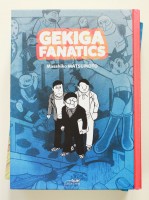 If any publishers are reading this, I have a very specific licensing request. There’s a small French publisher called Lezard Noir that is publishing some amazing manga in French; I spoke to the publisher when I was in Angouleme two years ago and was really impressed with his line, which includes Minetaro Mochizuki’s Chiisakobé, Bonten Taro’s Sex & Fury, and Masahiko Matsumoto’s Gekiga Fanatics. I’m not the only one—every year at least one of his books is picked as an official selection by the Angouleme festival. I’d love to see some U.S. publishers pick up these titles in a similar format—I think they would have a lot of appeal to those older, more sophisticated manga readers.
If any publishers are reading this, I have a very specific licensing request. There’s a small French publisher called Lezard Noir that is publishing some amazing manga in French; I spoke to the publisher when I was in Angouleme two years ago and was really impressed with his line, which includes Minetaro Mochizuki’s Chiisakobé, Bonten Taro’s Sex & Fury, and Masahiko Matsumoto’s Gekiga Fanatics. I’m not the only one—every year at least one of his books is picked as an official selection by the Angouleme festival. I’d love to see some U.S. publishers pick up these titles in a similar format—I think they would have a lot of appeal to those older, more sophisticated manga readers.
